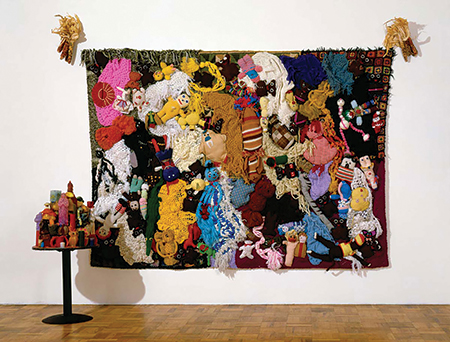
Continuing through July 28, 2014
It is hard to imagine, had Mike Kelley not passed away in 2012 at the age of 57, what new works would have been inserted into his vast retrospective. The exhibition, organized by Ann Goldstein (former Director of the Stedelijk Museum in Amsterdam) in cooperation with the Mike Kelley Foundation for the Arts, was first presented at the Stedelijk Museum, then traveled to MoMA PS1, New York and the Centre Pompidou, Paris, before completing its tour at the Geffen Contemporary in Los Angeles. This exhibition spans Kelley's career and includes both early and late works in all media, including photographs, sculptures, drawings as well as videos and multi-media installations in which he collaborated with other artists like Paul McCarthy and Jim Shaw. There was almost nothing Kelley was afraid to try and subject himself or his viewer's to.
Kelley was born in Detroit (1954), relocating to Los Angeles in the mid 1970s where he lived until his death. He came to be regarded as one of Los Angeles' most prolific and innovative artists for consistently confrontational, suggestive, offensive as well as politically charged works. He was a beloved teacher first at CalArts and later at Art Center College of Design, influencing generations of students who were saddened and shocked by his suicide. Kelley always pushed boundaries - be it via subject matter or presentation. His imagination was seemingly infinite and his engagement with a vast array of topics was mind-boggling.
Much of what we get here are quintessential "Mike Kelley" works, often first exhibited in Los Angeles (including at the Geffen). These include the room-sized installations "Pay For Your Pleasure" (1988), the "John Glenn Memorial Detroit River Reclamation Project" (2001) and "Deodorized Central Mass with Satellites" (1991/1999). "Pay For Your Pleasure" addresses the legacy of serial killer John Wayne Gacy. In addition to presenting a painting by Gacy, Kelley's installation consists of forty four-by-nine foot banners, each containing a portrait and a quote by a noted artist, writer or thinker that collectively address the relationship between criminal and creative thinking. Seeing a mass murder's artwork in this context conflates Gacy's celebrity and notoriety.
"Deodorized Central Mass with Satellites" is a multi-colored constellation of stuffed toys hanging from the ceiling. Organized by color, each bulbous form is at once enchanting and repulsive. The negative association with second hand toys is emphasized by the gleaming surface of similarly colored minimalist objects attached to the wall that periodically sanitize the air with a burst of perfume. "The John Glenn Memorial Detroit River Reclamation Project" features a larger than life size statue of astronaut Glenn covered with fragments of glass, pottery and toys that Kelley found in a Detroit riverbed. Beds containing more shards sorted by color surround the figure. Didactic materials about Kelley's Detroit boyhood entitled "Including the Local Culture Pictorial Guide, 1962-1972 (Wayne/Westland Eagle)" accompany the sculpture.
Based on the fictional city of Krypton, the home of Superman, the "Kandor Series" (1999-2011) of multi-media works present the alien city cast in resin and preserved in glass bottles. Kelley culled images of the city from numerous Superman comics to create three-dimensional versions that are enclosed in glass domes. They are dramatically lit and connected to tanks pumping in air or other substances. The connection and interest in Superman is apt, as Kelley had by then become an art world superhero who was expected to perform super human tasks, produce mountains of work and be in multiple places simultaneously.
"Horizontal Tracking Shot of a Cross Section of Trauma Rooms" (2009) appears at first to be a minimalist sculpture consisting of brightly colored vertical panels akin to out of synch colorbars. A sound emanates from the work, drawing viewers to its back side where three vertically oriented flat screen monitors are attached to the structure. The images of the screens alternate between bars of color and images of violence committed against children, which have been culled from YouTube. Kelley's use of these clips serves to draw attention to not only the proliferation of violence on the web, but also that they are frequently full of sadistic humor. "Horizontal Tracking Shot" is an apt example of the dialectics that are at play in much of Kelley's work. The dichotomies of good vs. evil, life vs. death, and beauty vs. ugliness characterize this dialectic and inform the push-pull that is implicit in Kelley's thinking and in his art.
Whether viewed thematically or chronologically, the trajectory of Kelley's career is often startling and surprising. He was an exceptionally skilled draftsman, yet also an exhibitionist and a performer who was able to overcome his native shyness by making works that were larger than life. Many of his pieces addressed his fears and his personal history, which ultimately formed an aesthetic cocoon that surrounded the man. The sheer volume and complexity of Kelley's endeavor reflects the struggle of his life as an artist and includes both the dark and light aspects of that conflict. However indecipherable the world may be, Kelley tried to make sense of it. This retrospective solidifies Kelley's position in the art historical canon as an innovator and provocateur.
